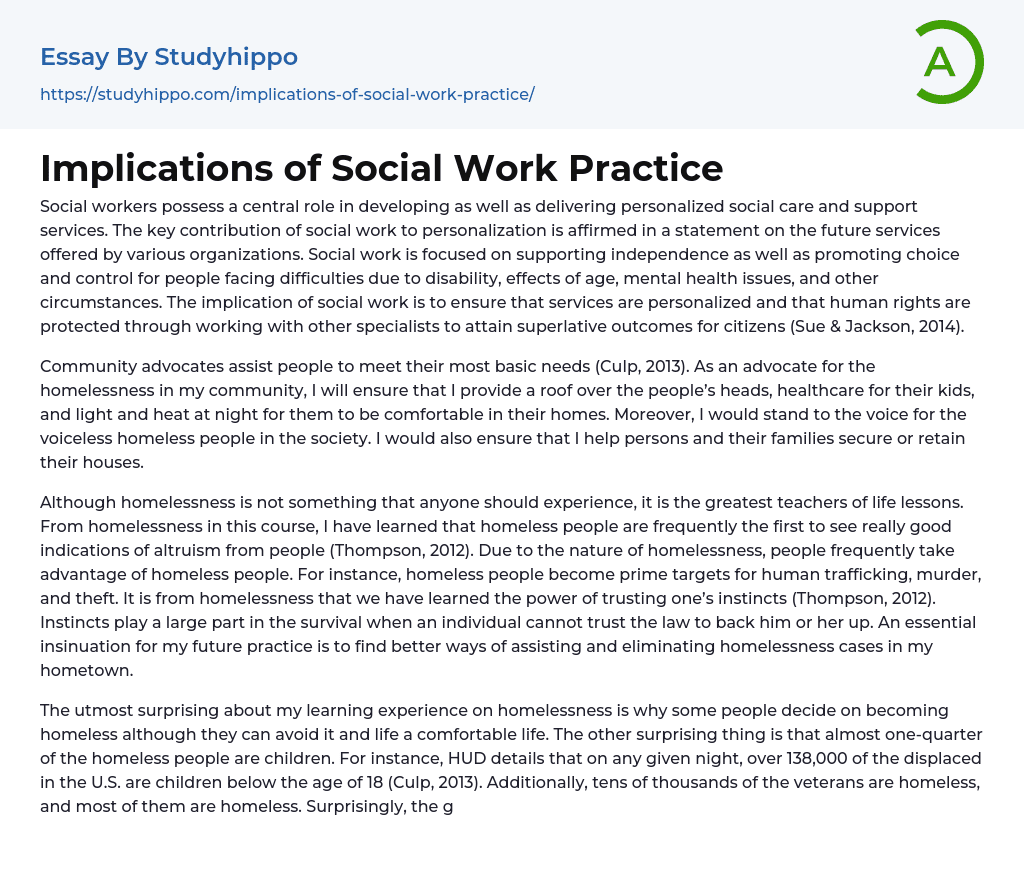Social workers possess a central role in developing as well as delivering personalized social care and support services. The key contribution of social work to personalization is affirmed in a statement on the future services offered by various organizations. Social work is focused on supporting independence as well as promoting choice and control for people facing difficulties due to disability, effects of age, mental health issues, and other circumstances. The implication of social work is to ensure that services are personalized and that human rights are protected through working with other specialists to attain superlative outcomes for citizens (Sue & Jackson, 2014).
Community advocates assist people to meet their most basic needs (Culp, 2013). As an advocate for the homelessness in my community, I will ensure that I provide a roof over the people’s heads, hea
...lthcare for their kids, and light and heat at night for them to be comfortable in their homes. Moreover, I would stand to the voice for the voiceless homeless people in the society. I would also ensure that I help persons and their families secure or retain their houses.
Although homelessness is not something that anyone should experience, it is the greatest teachers of life lessons. From homelessness in this course, I have learned that homeless people are frequently the first to see really good indications of altruism from people (Thompson, 2012). Due to the nature of homelessness, people frequently take advantage of homeless people. For instance, homeless people become prime targets for human trafficking, murder, and theft. It is from homelessness that we have learned the power of trusting one’s instincts (Thompson, 2012). Instincts play a large part in the survival
when an individual cannot trust the law to back him or her up. An essential insinuation for my future practice is to find better ways of assisting and eliminating homelessness cases in my hometown.
The utmost surprising about my learning experience on homelessness is why some people decide on becoming homeless although they can avoid it and life a comfortable life. The other surprising thing is that almost one-quarter of the homeless people are children. For instance, HUD details that on any given night, over 138,000 of the displaced in the U.S. are children below the age of 18 (Culp, 2013). Additionally, tens of thousands of the veterans are homeless, and most of them are homeless. Surprisingly, the government does not help as much as many people think. It is also very surprising that many cities are increasingly considering homelessness a crime instead of finding ways of helping those affected to live a better life (Culp, 2013).
The homeless subpopulation I have identified and that I would like to become an advocate is Ventura County that has been hit by homelessness due to the state of the people living in the city (Thompson, 2012). Advocacy is the active backing of an idea or causes expressed through strategies as well as methods that affect the decisions of people and organizations. The strategies I will employ will comprise of creating policies regulations, distribution of resources and laws that affect people’s lives besides ensuring that decisions lead to implementation (Culp, 2013). My advocacy allies will be the people in the community that have been affected by homelessness since I will be working with them to ensure the issue is brought
to a halt.
The best way to advocate for the homeless advocating to end child and family homelessness is by adequately funding and safeguarding emergency service programs for families as well as persons experiencing homelessness (Martin, 1997). Furthermore, increasing funding for housing programs serving extremely low-income households would also serve as a solution to them. Veterans have inconsistent rates of mental illness, predominantly PSTD depression, military sexual trauma, and anxiety (Martin, 1997). The five steps advocating for homeless veterans include identifying all homeless veterans in the community and create a shareable master list. Secondly, classifying all available housing stock comprising presently existing and potential stock. Thirdly, setting a clear numerical goal as well as a timeline for getting veterans housed and frequently track their progress. Fourthly, recognizing the needed sympathetic services as well as resources for veterans and finally to house the veterans (Martin, 1997).
References
- Thompson, T. (2012). Homelessness. Detroit: Greenhaven Press.
- Sue, D. W., & Jackson, K. F. (2014). Multicultural social work practice.
- Culp, A. M. D. (2013). Child and family advocacy: Bridging the gaps between research, practice, and policy. New York, NY: Springer.
- Martin, M. (1997). Heading Home: Breaking the Cycle of Restlessness Among Americas Veterans, a Post-Summit Action Report and Resource Directory. DIANE Publishing,.
- Adult essays
- Aggression essays
- Altruism essays
- Archetype essays
- Behavior essays
- Certainty essays
- Conformity essays
- Deception essays
- Human Behavior essays
- Human Sexuality essays
- Maturity essays
- Morality essays
- Obedience essays
- Procrastination essays
- Reinforcement essays
- Role Model essays
- Homelessness In America essays
- Adoption essays
- Aunt essays
- Babies essays
- Bedroom essays
- Caring essays
- Children essays
- Daughter essays
- Divorce essays
- Dog essays
- Dysfunctional Family essays
- Family Tradition essays
- Family Values essays
- Father essays
- Foster Care essays
- Friends essays
- Grandparent essays
- Home essays
- Hometown essays
- Husband essays
- Jealousy essays
- Love essays
- Marriage essays
- Mother essays
- Online Dating essays
- Parenting essays
- Parenting Teens essays
- Parents essays
- Relationship essays
- Room essays
- Sibling essays
- Sister essays
- Wedding essays
- Wife essays




